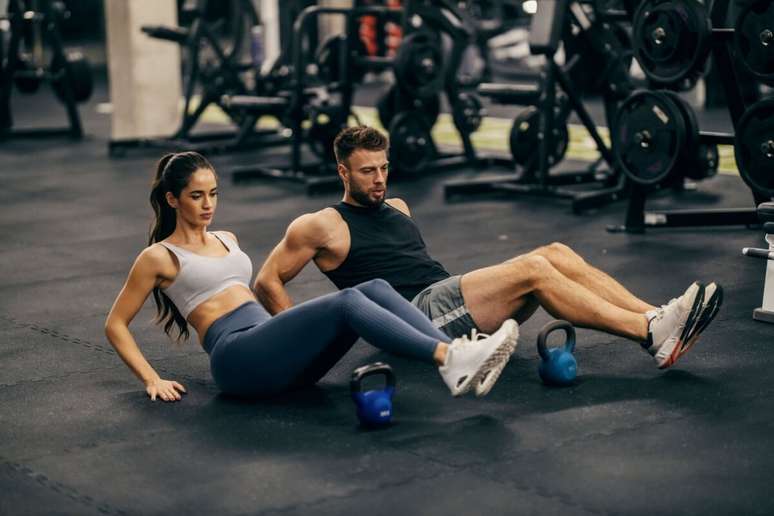Learn some exercises to do at home and work in this region
With the aim of maintaining body health, many people go to the gym and do exercises to tone their biceps, triceps and abdomen. However, the muscles of the pelvic region, which also need care, are often forgotten. However, a weakened pelvic floor can have several health consequences.
“Weakening of the pelvic floor can result in involuntary urine leakage, fecal incontinence, pain, discomfort, bowel problems, sexual dysfunction and pelvic organ prolapse, resulting in weakening of the organ support structures in the region, leading to displacement or loss of organs such as the bladder, uterus or rectum,” says sex therapist Claudia Petry, member of SBRASH (Brazilian Society for the Studies of Human Sexuality).
According to Claudia Petry the pelvic floor is a set of muscles and tissues located in the lower region of the pelvis – between the hip bones – whose function is to support the pelvic organs (bladder, uterus and rectum). “These muscles ensure control of the urinary and anal sphincters; they also play an important role in pelvic stability and sexual function,” says the specialist.
Causes of a weak pelvic floor
There are several factors that can compromise the functions of the pelvic floor. Among women, the most common ones relate to pregnancy and childbirth. “During this phase, the pelvic floor muscles are under great pressure, which can cause weakening and injury. As years go by, the tissues in the region can become more fragile and lose their natural elasticity, causing problems,” he explains the sexologist. .
In men the condition is less frequent, but this does not mean that they cannot have it, especially if they are obese or perform very intense physical activity. “Excess weight can also overload the pelvic floor muscles, causing them to weaken and malfunction. Practicing high-impact physical activities, such as running and jumping, can cause excessive tension in the muscles in the region, resulting in injuries,” explains the specialist .
Apart from these, surgical procedures in the region, such as hysterectomy and prostateand inappropriate lifestyle habits, such as excessive efforts during toileting and poor posture, are on the list of factors that compromise the region.
Strengthen the pelvic floor
Pelvic floor dysfunction can generally be treated without the need for surgery. However, only a qualified healthcare professional should recommend the most appropriate treatment. Among the most common, according to the sexologist, there are:
- Biofeedback: is a method that uses devices to measure pelvic floor muscle activity. Helps people better visualize and understand muscle movements, helping them with proper training and strengthening;
- Electrical stimulation: consists of using mild electrical currents to stimulate the pelvic floor muscles. Helps strengthen muscles more intensely;
- Behavioral therapy: involves identifying and modifying habits and behaviors that may contribute to a weakened pelvic floor, such as inappropriate postures or practices that overload the muscles;
- Manual therapy: It can be performed by physiotherapists specializing in the pelvic floor. It involves techniques such as massage, mobilization and myofascial release to relax and strengthen the pelvic floor muscles.
“It is important to consider strengthening these organs as part of a health routine, both to prevent future problems and to treat existing cases of weakening,” emphasizes Claudia Petry. The pelvic physiotherapist Débora Pádua adds: “today there are, in the pelvic physiotherapy offices, Games so that the tightening isn’t so boring and repetitive and some cones and vaginal probes to train and make the process a lot more fun.”

Exercises to strengthen the pelvis at home
In addition to treatments, some physical exercises can be done at home to strengthen the pelvis without the need for equipment, such as:
- Bridge exercise: Lie on your back with your knees bent and your feet flat on the floor. Contract your pelvic floor muscles and, at the same time, lift your hips off the floor, forming a straight line from shoulder to shoulder. knees. Hold this position for a few seconds and then lower your hips;
- Contraction and relaxation exercise: Sit comfortably and contract your pelvic floor muscles as if you are trying to stop the flow of urine. Hold the contraction for a few seconds and then relax completely. Repeat this process several times;
- Deep breathing exercise: Sit comfortably, close your eyes and breathe deeply through your nose, filling your lungs. Then, slowly exhale through your mouth while relaxing your pelvic floor muscles. Repeat the process 3 times.
According to Cláudia Petry, the results of the exercises are generally noticeable already in the first few weeks. “However, to achieve significant and long-lasting effects, it may take a longer period of time, usually a few months. It is important to remember that consistency and regular exercise are essential for the most satisfactory results,” she says.
Be careful when practicing the exercises
Despite the effectiveness of this type of practice, Débora Pádua warns: “before doing the exercises, the ideal is to evaluate yourself to make sure there are no contraindications […]remembering that we must strengthen ourselves with the contraction and learn to relax or we can also have an excess of contraction and generate pain in the region.”
In other words, to strengthen this region it is important to also know your body. “It is essential to know and activate the pelvic floor muscles correctly, respect the limits of the body, perform the exercises with the correct technique, be consistent and observe the warning signs, such as pain or discomfort. Adapt the exercises according to individual needs it’s fundamental”, says Cláudia Petry.
Difference between pelvic physiotherapy and pompoarism
Pelvic physiotherapy and pompoirism are different, but they are related because they work on the pelvic region; Therefore, they are often confused by the public. To clarify, experts explain the purpose of each. “Pelvic physiotherapy aims to improve overall health and helps women with problems such as back pain, sexual intercourseimproving continence, sexual dysfunctions, pelvic dysfunctions and care during childbirth and postpartum”, says Débora Pádua.
On the other hand, pompoarism strengthens and tones the pelvic floor muscles, improving body awareness and sexual pleasure. “Pompoirism is performed through specific exercises to contract and relax the vaginal muscles, using accessories such as Thai balls,” explains Cláudia Petry. Débora Pádua adds: “those who have dysfunctions often have no signs of pompoarism, which is why a specialist is always recommended to help them.”
Source: Terra
Ben Stock is a lifestyle journalist and author at Gossipify. He writes about topics such as health, wellness, travel, food and home decor. He provides practical advice and inspiration to improve well-being, keeps readers up to date with latest lifestyle news and trends, known for his engaging writing style, in-depth analysis and unique perspectives.






![Tomorrow Belongs to Us: What’s in store for Wednesday 22 October 2025 Episode 2058 [SPOILERS] Tomorrow Belongs to Us: What’s in store for Wednesday 22 October 2025 Episode 2058 [SPOILERS]](https://fr.web.img6.acsta.net/img/95/64/95643daa3fa690142f3135b300b4ef9d.jpg)

